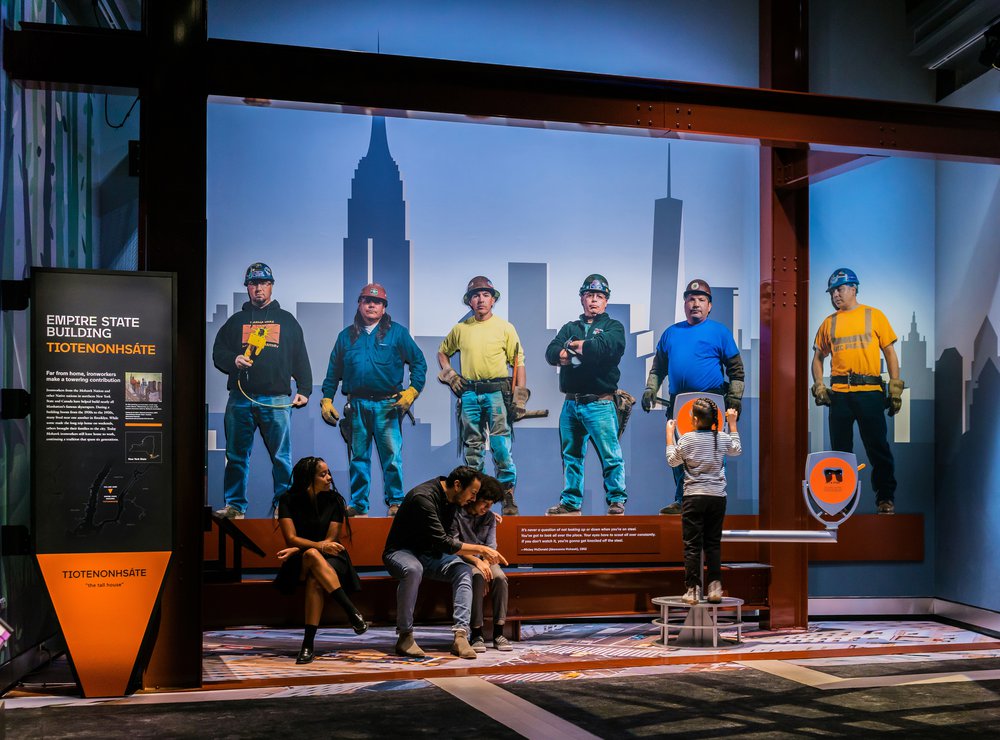“Native New York” Re-Examines The Place Of Native Americans Beyond Colonization
Oct. 30, 2021, 9:30 a.m.
The National Museum of the American Indian’s new exhibition subverts the standard narrative.

Much of the time when non-indigenous children are taught about the history of Native American people, it's just that: history. And there's little acknowledgement of their existence beyond the colonial era. But a new ongoing exhibition at the National Museum of the American Indian in Manhattan aims to change that narrative by shining a light on the tribes with roots in New York.
“Native New York” is located just off the museum’s central rotunda, and tells the story of the state’s American Indian communities by taking visitors on a trail from Long Island to Niagara Falls. There are displays of objects, like wampum belts used during ceremonies and lacrosse sticks; interactive games that let players experience how trade between tribes was disrupted by the arrival of early Dutch colonists; and interviews with the leaders of tribal communities that both either remained in New York or were forced to other parts of the country as a result of government displacement policies.
All together, the exhibition subverts old narratives that typically relegated Native Americans to New York’s history books while ignoring the active and vibrant communities. Photographs of Mohawk steelworkers are displayed next to images of Manhattan iconic skyscrapers they helped build. Comic book-style illustrations depicting historic moments are juxtaposed with photographs of the modern-day sites.
As a package, “Native New York” insists on placing these histories, and the people affected by them through the generations, solidly in conversation with contemporary New York.
Dr. Gabrielle Tayac (Piscataway), an associate professor of history at George Mason University, co-curated the exhibition. She spoke with WNYC/Gothamist about her research and intentions in crafting “Native New York.” The interview has been lightly edited for clarity.
Listen to WNYC host David Furst's interview with Dr. Gabrielle Tayac:
The big question the exhibition asks is "what makes New York a native place?" How would you answer that?
Well, it's really an ongoing question and I so appreciate that you have picked up on the continual nature that is often so invisible in New York City and New York State. We see the names, for example, even “Manhattan” comes from the term "Manahatta," which means "where the hickory bows were made." We have names and places and lives that are shaped from across history, but it's also a place where Native American people still live. There's a large urban population in New York City. And then there are also tribal nations, which continue and persist across the state of New York.
Now, the exhibition examines some parts of American history that may be very familiar to people, but re-contextualizes these moments from a Native American perspective. What are some of the moments that really stuck out to you while curating the exhibit?
So I did about five years of research based in the communities that stayed in New York, and also are in diaspora. The original Lenni Lenape people of lower New York, of Manhattan, New York City, the Hudson Valley, the majority of those people were pushed out early on to Wisconsin, Ontario, Oklahoma, where they are now. And one of the things that really, really struck me deeply was how they carried the memories of the landscape of New York, like in their clothing, in their songs, in their language of places that they had never seen. You know, it's like, how do you remember a place where you've never been? How do you carry a past that you're cut off from?
And we're really getting to the double meaning of that phrase we hear all the time, "native New Yorker," right?
Absolutely. And I chose that term, I decided to title the exhibit "Native New York" to play on that idea to think about what does it mean to have that level of originality? What does it mean to create a sense of home, a sense of place, both for people who have been in that area for thousands of years, who were cut off from it and want to touch base with it. And at the same time, it's really important no matter who you are, if you are walking those steps on the city and you have created that home and it's gotten under your skin and into your blood to have a deeper sense of place. I believe in the 2000 Census New York had the largest American Indian population in the United States. And also, so many of the skyscrapers that have been built, including the Empire State Building, our lost World Trade Center, and the one that has risen again, have Mohawk and other Haudenosaunee high steel workers hands on them. They call themselves "skywalkers" and they are still involved in the construction of the high steel buildings within New York City. Native people have built this city from its very beginnings and Native New Yorkers have been tough through and through. And that's what I think lies in the future.
"Native New York" is now on display at the National Museum of the American Indian, 1 Bowling Green, New York, NY 10004 from 10 a.m. to 5 p.m. Monday through Friday.